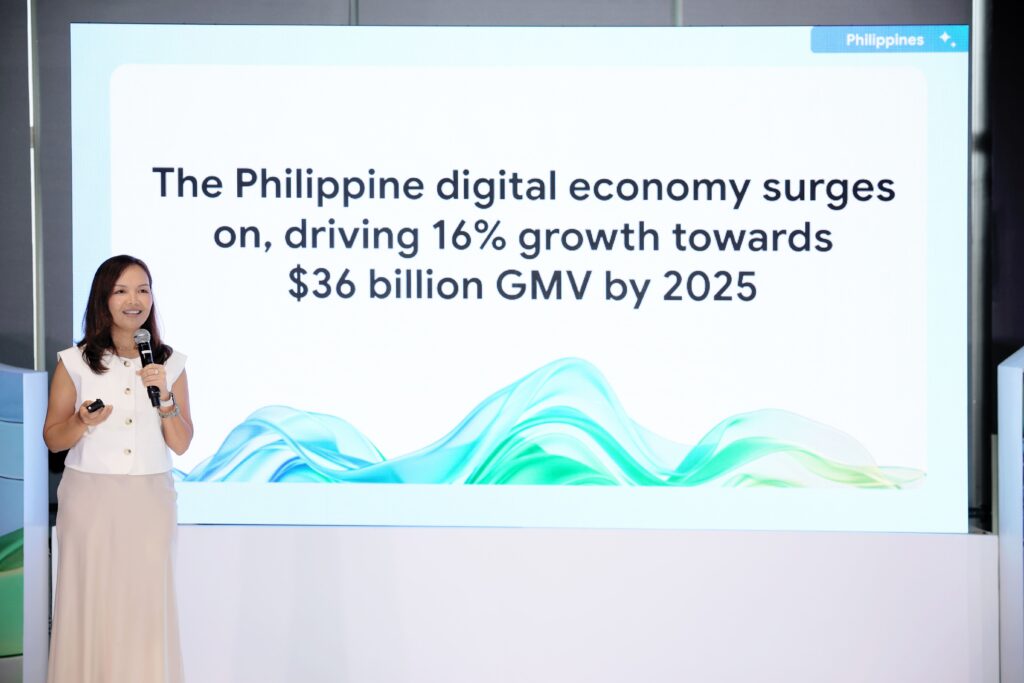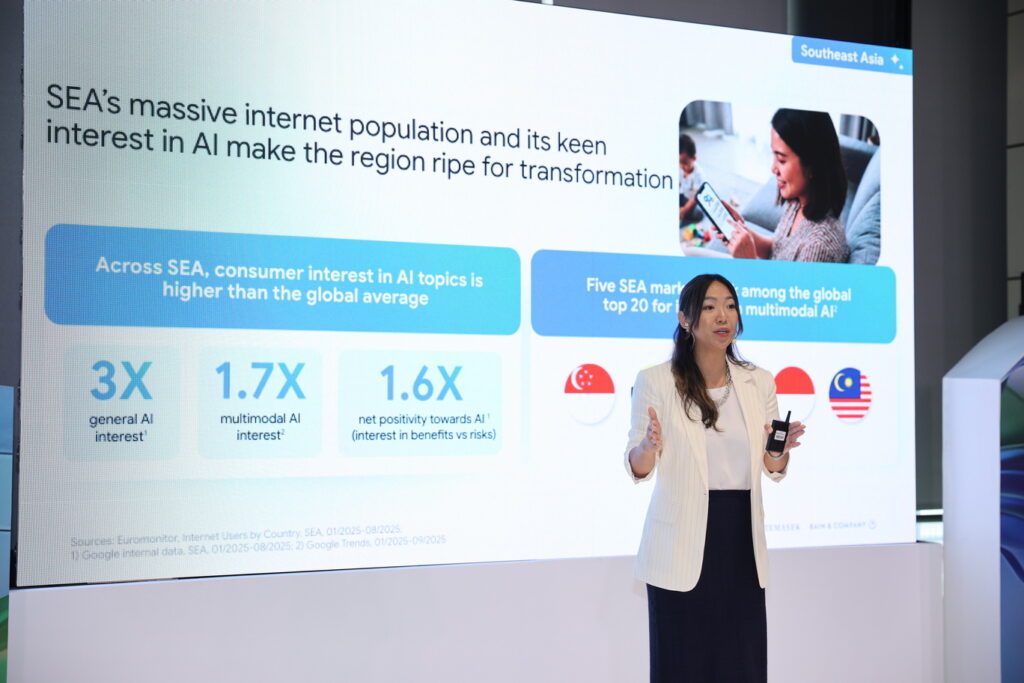NOVEMBER 25, 2025, MANILA, PHILIPPINES – The Philippine digital economy is sustaining powerful double-digit growth, remaining firmly on track to hit $36 billion in Gross Merchandise Value (GMV) by 2025, according to the 10th edition of the e-Conomy SEA 2025 Report, titled “From Digital Decade to AI Reality: Accelerating the Future in ASEAN.”
Published by Google, Temasek, and Bain & Company, the report highlights the country’s 16% YoY growth, which is driven by a vibrant ecosystem: innovative platforms, a tech-positive regulatory environment, and AI-curious consumers with increasing spending power. This momentum is driving a greater use of e-commerce, digital payments, and on-demand services across the country.
Driving double-digit growth across sectors
All key digital economy sectors are sustaining double-digit growth, and the e-commerce sector remains the largest contributor to the Philippines’ GMV, accounting for more than 60% of the overall digital economy.
- E-commerce and video commerce: Digital platforms are leveraging AI to refine user experience, leading to more personalized shopping journeys and sustaining robust growth within the sector. A big finding in this year’s e-Conomy SEA Report is that a major growth driver for the Philippines is video commerce, which is witnessing explosive growth in a high-volume, low-cost market. There are now around 475,000 sellers and stores utilizing video commerce, a 90% YoY growth from 2024, resulting in a transaction volume of 1.2 billion (+35% year-on-year). Video commerce also contributes significantly to overall e-commerce GMV, with 28% from fashion and accessories and 23% from beauty and personal care making up half of the total contribution from this category.
- Online Travel: As a result of the ongoing post-pandemic travel boom and recovery, the GMV and revenue from online travel in SEA has grown 11% to $51 billion GMV (across both flights and accommodations) and $24 billion revenue. This has influenced the Philippines with +14% growth YoY and $4 billion GMV from online travel in 2025. Aside from the recovery of travel, the increased GMV is also due to higher fares and prices across the board. As for where Southeast Asians are going, both foreign visa policies and tourism campaigns continue to influence plans and itineraries.
- Online Media: The GMV from online media across the region saw a double-digit jump of +14% from 2024, largely thanks to the growth from advertising (16% in 2025 from 14% in 2024) and gaming (6% from 5%). The Philippines has the fastest-growing online media sector at +16% YoY, alongside Vietnam and Indonesia.
- Digital Financial Services (DFS): DFS also sees double-digit growth across all sectors (+19% for digital payments, +18% for digital lending, +24% for digital wealth, +16% for digital insurance), due to integrated offerings successfully catering to financially mature consumers across the region. The Philippine digital economy’s digital wealth sector grew by +36% while insurance surged by +27%, notching $2 billion in assets under management (AUM) and $0.1 billion in AUM and gross written premium, respectively. The country also records the second-fastest growing digital payments sector at +20% and $150 billion gross transaction value, behind only Indonesia.
- Transport & Food Delivery: The region continues to see steady GMV growth in food delivery, with +14% and $22 billion in GMV and +18% and $2.4 billion in revenue this year. It’s also the same story in transport, with +16% and $11.1 billion in GMV and +17% and $1.8 billion in revenue. The Philippines sits at the top alongside Vietnam as the fastest-growing transport and food sector at +20%. Operational efficiency, optimized logistics, and personalized service offerings—all powered by AI—are driving continued, disciplined growth as players focus on sustainable profitability.
Rapid AI adoption across the Philippine digital economy
When it comes to AI, one of the centers for real, rapid growth in usage is the Philippines, which is among the five Southeast Asian markets that rank in the top 20 global markets showing interest in multimodal AI—a type of AI that processes information from various data sources, typically text, images, audio, and video. Filipinos continue to show momentum when it comes to AI adoption:
- Widespread, regular use: AI is increasing its utility, with 78% of Filipino digital users saying they use AI-powered tools to help them discover content and make tasks easier. Meanwhile, 43% said that saving time on research and comparisons is the main motivation for using AI features.
- Active workforce adoption and upskilling: The report found that the enrollment growth in generative AI courses in the Philippines has grown 4.8X, the second highest in the region after Vietnam at 5.2X. 77% of Filipino workers have already taken steps to learn how to use AI tools, confirming the nation’s proactive stance on readiness and upskilling for the future of work.
- Booming commercial momentum and high trust: Strong consumer interest and adoption of AI are driving commercial momentum in the Philippines. Apps marketing their AI features have seen revenue surge by +79%, driven by the practical value that encourages Filipinos to upgrade their plans. These key benefits include saving time on research and comparisons, saving money through better deals, and gaining enhanced security and fraud protection. This widespread adoption is underpinned by 94% of Filipinos who said they are willing to share data access with AI agents (e.g., shopping and viewing history, social connections).

“The Philippines is a digital powerhouse, sustaining its double-digit growth and firmly on track to hit $36 billion in GMV by 2025. This momentum is not a temporary spike; it’s a sustained, systemic transformation—a convergence of innovative platforms, a tech-positive regulatory environment, and our uniquely AI-curious Filipinos consumers with real spending power. With digital adoption accelerating nationwide and reaching beyond major cities, the real story is that our digital economy is becoming truly ubiquitous, preparing us for the dawn of the new era: AI. The imperative now for the whole ecosystem is to partner together and strategically leverage this momentum to ensure that more Filipinos are well-equipped to reap the benefits of AI,” said Prep Palacios, Country Manager, Google Philippines.
“Southeast Asia’s digital economy has shown extraordinary growth and remarkable resilience, sustaining momentum despite periods of investor caution and a shifting macroeconomic landscape over the last decade. The Philippines remains one of the region’s fastest-growing digital economies, fueled by strong momentum in e-commerce, transport, and food delivery, and supported by a digitally confident population embracing digital payments and financial services, putting it on track to reach $36 billion in GMV by 2025. Growing consumer interest and adoption of AI signal the country’s readiness to turn digital momentum into long-term value creation. The real opportunity now lies in how businesses harness AI as a catalyst for impact while addressing the country’s unique structural realities,” said Bennett Aquino, Partner, Bain & Company.

Download the full e-Conomy SEA 2025 Report here.


